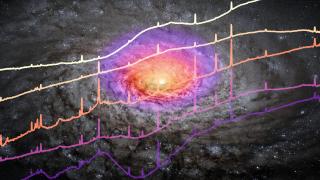Bibcode
de Sá-Freitas, Camila; Fragkoudi, Francesca; Gadotti, Dimitri A.; Falcón-Barroso, Jesús; Bittner, Adrian; Sánchez-Blázquez, Patricia; van de Ven, Glenn; Bieri, Rebekka; Coccato, Lodovico; Coelho, Paula; Fahrion, Katja; Gonçalves, Geraldo; Kim, Taehyun; de Lorenzo-Cáceres, Adriana; Martig, Marie; Martín-Navarro, Ignacio; Mendez-Abreu, Jairo; Neumann, Justus; Querejeta, Miguel
Referencia bibliográfica
Astronomy and Astrophysics
Fecha de publicación:
3
2023
Revista
Número de citas
29
Número de citas referidas
25
Descripción
The epoch in which galactic discs settle is a major benchmark for testing models of galaxy formation and evolution but remains largely unknown. Once discs settle and become sufficiently self-gravitating, stellar bars are able to form; therefore, determining the ages of bars can shed light on the epoch of disc settling, and on the onset of secular evolution. Nevertheless, timing when the bar formed has proven challenging. In this work we present a new methodology for obtaining the bar age, using the star formation history of nuclear discs. Nuclear discs are rotation-supported structures, built by gas pushed to the centre via bar-induced torques, and their formation is thus coincident with bar formation. In particular, we used integral field spectroscopic data from the TIMER survey to disentangle the star formation history of the nuclear disc from that of the underlying main disc, which enables us to more accurately determine when the nuclear disc formed. We demonstrate the methodology on the galaxy NGC 1433 - which we find to host an old bar that is 7.5−1.1+1.6(sys)−0.5+0.2(stat) Gyr old - and describe a number of tests carried out on both the observational data and numerical simulations. In addition, we present evidence that the nuclear disc of NGC 1433 grows in accordance with an inside-out formation scenario. This methodology is applicable to high-resolution integral field spectroscopic data of barred galaxies with nuclear discs, making it ideally suited for the TIMER survey sample. In the future we will thus be able to determine the bar age for a large sample of galaxies, shedding light on the epoch of disc settling and bar formation.
Proyectos relacionados

Huellas de la Formación de las Galaxias: Poblaciones estelares, Dinámica y Morfología
Bienvenida a la página web del g rupo de investigación Traces of Galaxy Formation. Somos un grupo de investigación amplio, diverso y muy activo cuyo objetivo principal es entender la formación de galaxias en el Universo de una manera lo más completa posible. Con el estudio detellado de las poblaciones estelares como bandera, estamos constantemente
Anna
Ferré Mateu

Actividad Nuclear en Galaxias: una Perspectiva 3D del Núcleo y su Entorno
Nuestro proyecto puede dividirse en dos líneas principales de investigación. En primer lugar, el estudio de los vientos producidos por cuásares luminosos oscurecidos y del impacto que estos tienen en sus galaxias anfitrionas (retroalimentación del AGN). Para ello hemos obtenido observaciones en el óptico e infrarrojo cercano con el Gran Telescopio
Cristina
Ramos Almeida